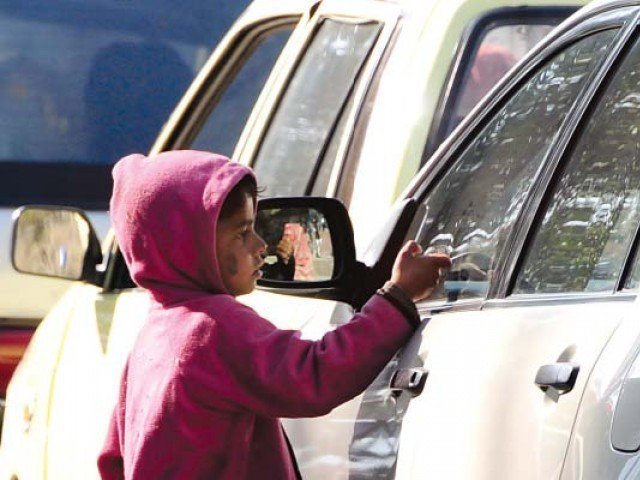
While most people gave in to her pleas and donated some money, those who dared to refuse or ignore her invited trouble.
“You haven’t paid me. I pray you don’t reach your destination safely. May you die in a terrible accident,” she cursed.
While the teenage beggar resorted to cursing and verbally abusing people who refused to give money to her, other beggars went a step further and even tried physically assaulting visitors.
It is not only lone wolves who coerce people to pay. If someone shows too much resistance, beggars gang up and surround them from all sides. Some hold their hands by force, while others keep poking them with their fingers.
For God’s sake: The beggar mafia gears up for Ramazan
According to visitors, being harassed by beggars is not a one-off incident as it happens on a daily basis. Some even believe that the act of forcing people to pay is not just begging anymore; the behaviour has become synonymous with extortion.
“I have literally seen people running away from the beggars to sit in their cars. Some of the beggars even run after cars in an attempt to stop the drivers. Sometimes, people are forced to stop when beggars deliberately run in front of the cars,” said Dr Faisal Malhi, a resident of Sadiqabad district who came to visit the shrine.
“If you pay to one of them, then hordes of them come asking for money too. Upon refusal, they become violent because they feel entitled,” he added.
Per sources, dozens of beggars throng the shrine every morning, waiting for their next prey.
“Since people from all over the country come to visit the shrine, the beggar mafia is well-aware that people always carry some money with them. That’s why they target them,” Dr Malhi said.
The situation is not specific to the shrine of Lal Shahbaz Qalandar, as a similar scenario is witnessed at almost all the shrines in Sindh. The situation in Sehwan, however, is getting out of control.
This shrine falls in the constituency of Sindh Chief Minister Syed Murad Ali Shah. Two years ago, the provincial government imposed a ban on beggary in the province, especially when minors are involved. However, no action has been taken against the beggar mafia so far.
“These beggars are humiliating people who come here to pay tribute to Qalander,” Dr Malhi said. “I was forced to pay a total of Rs500 to various beggars before I was allowed to enter the mazar. Upon coming out of the shrine, I was welcomed by a new group of beggars, who started poking me all over. I had to eventually pay to them to get back to my car as soon as possible.
Speaking to The Express Tribune, the provincial coordinator at the Child Rights Movement Kashif Bajeer said that the beggar mafia has become a menace.
"There is no rehabilitation center in the entire province to shift these beggars over there,” he said adding that Sindh Children Act 1955 and Child Protection Authority Act 2011 exist, but implementation on the same is big challenge for the government.
“The Sindh government had promised to establish 29 child protection units in all districts, but all in vain,” he said adding that government allocates budget every year but the fund gets lapsed at the end of the fiscal year.
“Young beggars, especially girls, are sexually assaulted on footpaths and many cases have been reported. At times, people give money to the girls but they ask for sexual favours in return. Some even run away without paying, which makes these children extremely frustrated,” he explained.
Mustafa Meerani, a social activist in Sehwan said that the problem is not with beggars in itself but it is the failure of the government to provide them with shelter and means of living.
“There are around 25 shrines in Sehwan, which come under the auqaf department, but officials and police are involved with the beggar mafia,” he said.
“The police can handle the situation well by telling the beggars off, however, some corrupt officers take bribe from the beggars and allow the practice to continue,” Meerani added.
A begging bowl that won’t break
He also shared that each child beggar earns around Rs1,000 to 2,000 daily through begging, so their parents see it as a lucrative “job” and send their children to beg at the shrines instead of sending them to schools.
According to Mirani, the former chief minister of Sindh Syed Abdullah Ali Shah, who was the father of the incumbent CM Murad Ali Shah, had envisaged a plan to develop a rehab centre with the help of Sindh Education Foundation to shift all young beggars there. However, the scheme could not see the light of day.
Despite repeated attempts, the secretaries of the social welfare departments and the auqaf department could not be reached for comment. However, the chief administrator of the auqaf department Munwar Mahesar said that they have launched a crackdown against the beggars and will soon devise a policy to end beggary at the shrines.
Published in The Express Tribune, December 25th, 2019.

























1714024018-0/ModiLara-(1)1714024018-0-270x192.webp)









COMMENTS (1)
Comments are moderated and generally will be posted if they are on-topic and not abusive.
For more information, please see our Comments FAQ